 |
Basil
A pungent herb much used in the Mediterranean regions and in South East Asia. Three varieties of basil are used in Thai cooking - bai kaprow (Holy or purple basil), bai horapa (sweet basil), and bai mangluk (lemon or hairy basil), |
|
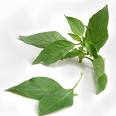 |
Holy basil (bai kaprow)
Holy basil has a hot flavor and slightly medicinal. It has a purple stem and purple leaves, usually used in stir-fried menu such as Stir-Fried Chicken with holy basil leaves (Pad Krapao Gai). |
 |
Sweet basil (bai horapa)
Bai horapa is the most popular. It has small, dark leaves with reddish-purple stems and flowers. Its flavor is reminiscent of aniseed and somewhat stronger than that of the western sweet basil. It is mainly used in many thai recipes such as Green Curry with Chicken [Kang Kaew Wan Kai], Stir-Fried Clams with Roasted Chili Paste [Hoy Lai Pad Num Prik Prao].
Lemon basil (bai manglak)
Lemon basil has a light green stem and light green leaves. It has a lemony flavor and is used in soups, salads, and curries. |
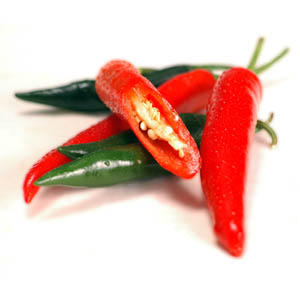 |
Chilli
There are many different kinds of chillies. The small, red and green fresh chillies, known as Thai or bird's eye, are extremely hot. Larger varieties are slightly milder. The 'fire' comes from the seeds so discard them if a milder flavour is preferred. Chillies contain volatile oil that can irritate the skin and cause eyes to burn. Always wash your hands immediately after using them. It is widely used in many thai recipes which are Spicy Soup with Prawn and Lemon Grass [Tom Yum Koong], Papaya Salad [Som Tum, etc. |
 |
Coriander
The leaves and seeds of the coriander plant are one of the most essential in Thai cooking. The root is also used, often pounded with garlic and other ingredients, to make a marinade. It is widely used as topping of many thai recipes such as Fried Fish with Tamarind Sauce [Pla Rad Prik], Thai Steamed Curried Fish [Haw Mok], etc. |
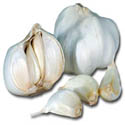 |
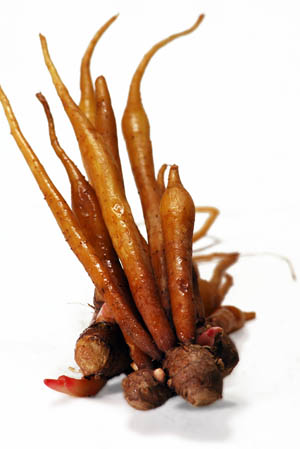 |
|
|
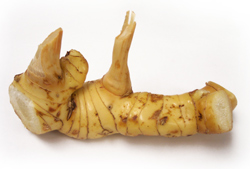 |
Galangal
A member of the ginger family that looks similar to fresh root ginger, but with a more translucent skin and a pinkish tinge. It has a wonderful sharp, lemony taste and it is prepared in a similar fashion to root ginger. Best used fresh, it is also available dried or in powder form. Thai Coconut Milk Soup with Chicken [Tom Kha Gai] reicpe is mainly used of this herb |
|
 |
Garlic
Garlic is indispensable in Thai cooking. Heads of the Asian variety are quite small. Look out for fresh shiny heads of garlic with no soft, dusty or moldy cloves. Jars of pickled garlic can be bought from Oriental stores. It is main ingredient of many thai recipes such as Fried Fish with Tamarind Sauce [Pla Rad Prik], etc. |
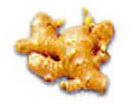 |
Ginger
A root of Chinese and Indian origin. It is always used fresh rather than dried and should be peeled and chopped or crushed before cooking. It is available in supermarkets. Look for shiny fat roots that aren't wrinkled or shrivelld. Though not used as frequently as galangal in Thai cooking, ginger makes a good alternative to galangal. |
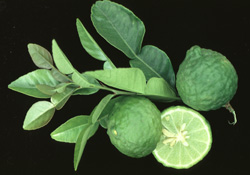 |
Kaffir Lime
This is similar to the common lime but has a knobby skin. The zest of the fruit is often used and the dark glossy green leaves from the tree impart a pungent lemony-lime flavor to soups, curries and other dishes. You can buy them fresh in Oriental stores. They keep well and can be frozen. Dried Kaffir limes are also available. Red Curry with Roasted Duck [Kang Phed Ped Yang] and Thai Steamed Curried Fish [Haw Mok] are thai recipes use this herb. |
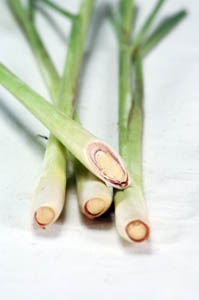 |
Lemon Grass
Also known as citronella, lemon grass has long pale green stalks and a bulbous end similar to a spring onion. Only the bottom 12cm/5in is used. It has a woody texture and an aromatic lemony scent. Unless finely chopped, it is always removed before serving because it is so fibrous. It is used as ingredient of one of the most famous thai recipe which is Spicy Soup with Prawn and Lemon Grass [Tom Yum Koong]. |
 |
Shallots
Thai shallots have a lovely pinkish purple color and are used extensively in Thai cuisine instead of onions, usually used in Thai Salad menu such as Thai vermicelli Salad with Prawns [Yum Woon Sen]. |
 |
Tamarind
An acidic tropical fruit that resembles a bean pod. It is usually sold dried or pulped. To make tamarind juice, take 25g/1oz of tamarind or about 2 stock cube-size pieces and leave to soak in 150 ml/1/4 pint 2/3 cup warm water for about 10 minutes. Squeeze out as much tamarind juice as possible by pressing all the liquid through a sieve and use as in the recipes such as Massaman Beef [Massaman Neur] . |

|





